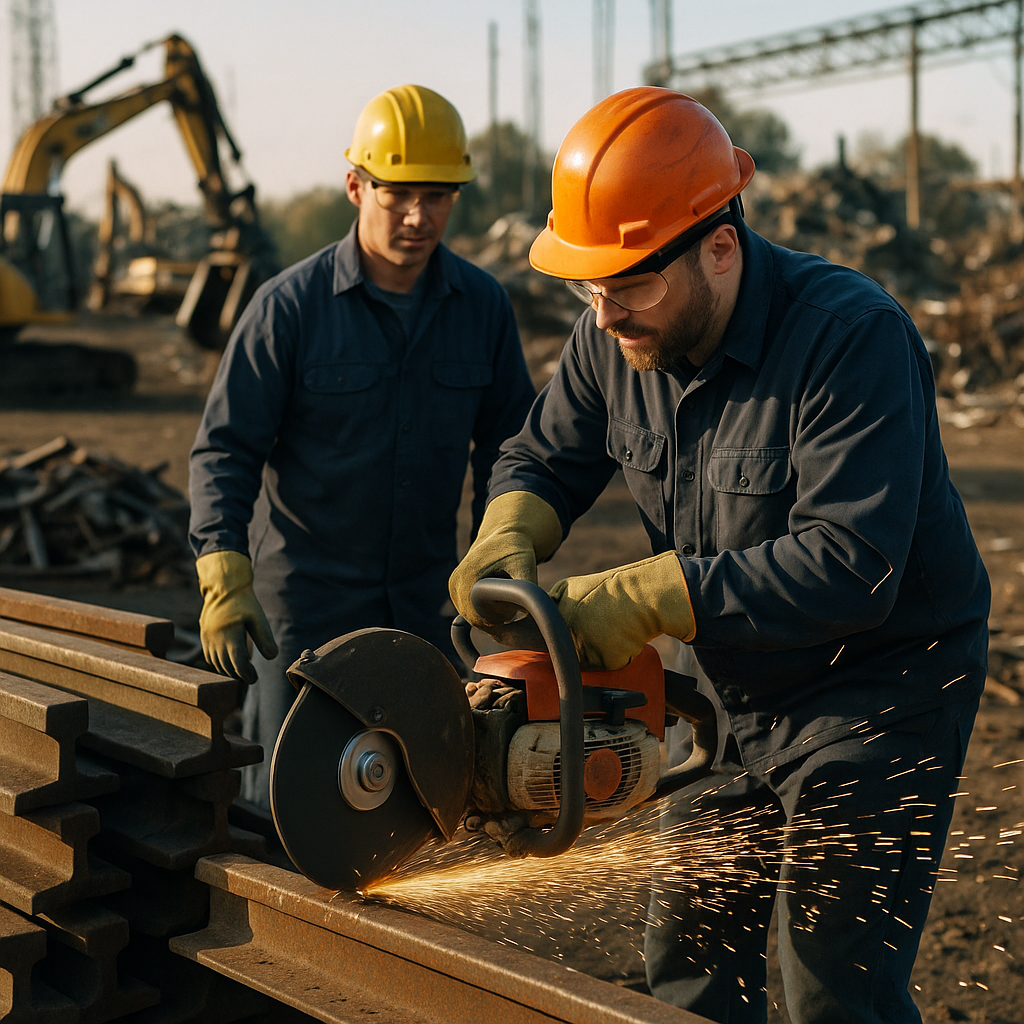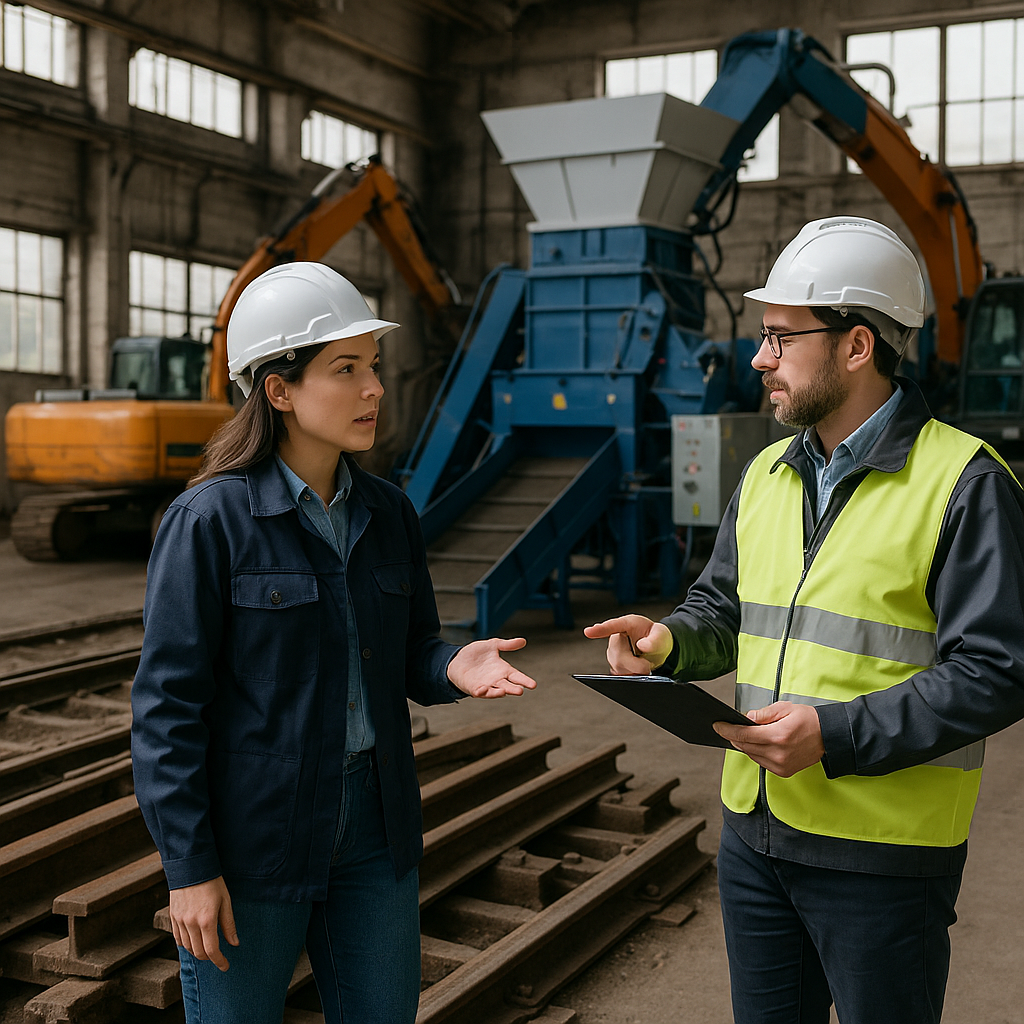5901 Botham Jean Blvd, Dallas, TX 75215
Learn the Process for Recycling Used Railroad Tracks and Steel Ties
August 2, 2025A single mile of railroad track can yield approximately 90 tons of recyclable steel. This valuable resource, once overlooked, now represents a significant opportunity in the sustainability sector. Railroad infrastructure recycling has evolved from simple disposal to sophisticated resource recovery systems.
The recycling of railroad tracks and steel ties follows a systematic process designed to maximize material recovery. These components, engineered for durability, contain high-grade metals that maintain their structural properties through multiple recycling cycles.
The first step involves carefully removing the steel rails from the railroad bed. Specialized equipment separates these heavy components from fastening systems, including spikes, tie plates, and rail anchors. These metal elements are sorted and transported to processing facilities where they begin their transformation into new products.
What Are the Environmental Benefits of Railroad Material Recycling?
Recycling railroad materials offers significant environmental benefits by conserving resources and reducing pollution. By recycling steel rails and metal components, valuable materials are kept within the circular economy instead of sending them to landfills. A mile of railroad track can provide approximately 90 tons of recyclable steel, significantly reducing waste.
Reducing carbon emissions is a primary benefit of railroad recycling. This process emits significantly fewer greenhouse gases compared to producing new metals from raw ore. Industry data shows that recycling existing metal consumes much less energy than extracting and refining virgin materials, thus decreasing the overall environmental impact.
Landfill Waste Reduction
Railroad recycling programs prevent substantial waste from ending up in landfills. Without recycling, decommissioned trains can generate waste comparable to 20 cars. Modern recycling techniques can now recover up to 97% of train materials for reuse or recycling.
Recycling steel and aluminum components, which constitute over 90% of most trains by weight, significantly reduces disposal needs while generating new resources for manufacturing.
Resource Conservation
Conserving natural resources is another crucial benefit of railroad material recycling. Reusing steel from decommissioned rail components reduces the necessity for new material extraction. For example, a single locomotive provides enough steel to manufacture over 100 cars, preserving natural landscapes from mining impacts.
Railroad tie recycling offers distinct advantages beyond metal recovery. Traditional disposal methods for creosote-treated ties can contaminate soil and water. Effective recycling prevents these environmental hazards and transforms potential waste into valuable products. Companies now convert old ties into engineered construction aggregate substitutes, reducing demand for more carbon-intensive materials.
Greenhouse Gas Reduction
Railroad recycling substantially decreases greenhouse gas emissions compared to conventional manufacturing methods. TiEnergy LLC reported saving 1.6 million pounds of carbon in 2023 through eco-friendly disposal methods for railroad ties, with each tie saving approximately 3.06 pounds of carbon.
This reduction supports global initiatives to limit temperature increases and combat climate change. By opting for recycling over new production, the railroad industry actively contributes to greenhouse gas reduction targets set by international climate agreements.
Ecosystem Protection
The environmental benefits of railroad recycling also include ecosystem protection. Decreasing mining activities preserves natural habitats and biodiversity, as reduced demand for virgin materials leads to fewer extraction sites and related disturbances.
Proper recycling safeguards water resources by preventing harmful chemicals from leaching into groundwater, protecting human water supplies and aquatic ecosystems from contamination.
Additionally, recycling eliminates fire risks linked to stored railway materials. Old ties in storage present significant fire hazards, but recycling mitigates these risks, thereby preventing air pollution and landscape damage.
Through comprehensive recycling programs, the railroad industry exhibits environmental leadership while creating economic opportunities. Markets for recycled railroad materials continue to expand as more industries recognize their value, bolstering the sustainability and economic viability of recycling initiatives.
What Is the Process for Recycling Used Railroad Tracks and Steel Ties?

The recycling process for railroad tracks and steel ties is a specialized operation requiring careful coordination, expert handling, and advanced technology. These steps ensure that the high-grade steel and other valuable materials are efficiently recovered, prepared, and returned to the manufacturing cycle. Understanding each stage provides insight into how the rail industry contributes to resource conservation and sustainability.
1. Decommissioning and Removal
The recycling journey begins with the safe decommissioning of a rail line. Trained crews use heavy machinery to remove the steel rails from the track bed, taking care to disconnect all fasteners, spikes, and plates without damaging the underlying materials. Modern rail-lifting equipment enables quick extraction of even the heaviest rails while minimizing disruption to the surrounding environment. Steel ties, which may be interspersed with wooden or composite ties, are systematically removed and sorted for further processing.
2. Sorting and Initial Processing
After removal, the rails, ties, and all associated hardware are transported to a sorting facility. Here, materials are separated based on type: steel rails, steel ties, non-ferrous metals, and any remaining wooden or composite components. Advanced sorting technologies—such as magnetic separators and automated conveyors—increase efficiency and purity. Steel rails and ties are then cut into standardized lengths, making them easier to handle and transport to recycling centers. Hazardous coatings or residues, such as creosote from steel ties, are addressed to ensure compliance with environmental standards.
3. Cleaning, Shredding, and Metal Recovery
At the recycling facility, the sorted steel components undergo thorough cleaning to remove soil, ballast residue, and contaminants. Industrial shredders or crushers break down the rails and ties into smaller, manageable pieces. The cleaned scrap steel is then melted in energy-efficient electric arc furnaces, which produce far less pollution and greenhouse gases than traditional steelmaking from raw ore. During this process, non-metallic materials are separated out, and the molten steel is poured into molds or cast into billets for use in new products. Even the recovered fasteners and hardware are melted down and reused, contributing to high recovery rates and a robust circular economy.
4. Final Quality Control and Distribution
Once the steel has been refined and cast, it undergoes stringent quality control tests to ensure its purity and strength meet industry standards. Only then is it certified for reuse in manufacturing, construction, or new railroad infrastructure. The final recycled products are then distributed to steel mills, fabricators, and manufacturers, closing the loop and reducing the need for virgin material extraction. Through this efficient and carefully monitored process, nearly all components from decommissioned railroad lines find new life in future projects.
Economic Impact of Railroad Material Recycling

Recycling railroad tracks and steel ties offers significant economic advantages to both local communities and the broader manufacturing sector. By reclaiming high-grade steel, this process reduces reliance on costly imports and supports the domestic steel industry. Industry analyses indicate that the North American rail recycling market is valued in the hundreds of millions of dollars annually, with demand increasing due to infrastructure upgrades and enhanced environmental regulations (DOE 2024).
Railroad material recycling also fosters job creation throughout the supply chain—from dismantling crews and transportation workers to processing plant employees and manufacturers. Recycled steel serves as a key feedstock for the production of new rails, structural beams, and automotive parts, helping stabilize prices and supply. Additionally, communities benefit from reduced landfill costs and potential tax incentives linked to sustainable waste management practices.
For railroad operators and recycling partners like Okon Recycling, monetizing decommissioned infrastructure provides a critical financial offset when investing in modern, safer rail systems. This closed-loop approach generates ongoing economic value while highlighting the importance of sustainability in the rail industry.
Challenges and Innovations in Railroad Recycling

Railroad material recycling, despite its advantages, encounters technical and regulatory challenges. A major concern is the handling of creosote-treated wooden or steel ties, which require specialized processes to prevent environmental contamination. Advances in tie-cleaning and decontamination technology have improved safety and efficiency, but strict adherence to environmental standards remains essential.
Additionally, dismantling and transporting extremely heavy and bulky rail components pose logistical challenges. Innovations such as mobile processing units and modular transport systems have streamlined operations, reducing downtime and costs. Tracking technology and digital inventory systems enable recyclers to document each step in the recycling process, enhancing transparency and regulatory compliance.
Looking ahead, research is ongoing to develop new alloys and recycling methods that improve the yield and purity of recovered metals. Industry partnerships between railroad operators, recyclers, and technology providers are driving advances in efficiency, safety, and environmental performance. These innovations ensure that railroad recycling remains a sustainable and economically viable practice well into the future.
Conclusion
Innovations in efficiency and safety are enhancing the role of railroad material recycling within the circular economy. From advanced sorting and decontamination to quality control and product distribution, each step is designed to maximize resource recovery and minimize environmental impact. Recycling railroad infrastructure signifies a strong commitment to sustainability and economic resilience for both communities and industries.
Ready to recycle old railroad tracks or steel ties? Call Okon Recycling at 214-717-4083 for expert rail material recycling services.
